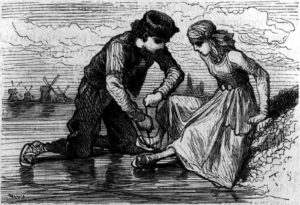
Hans Brinker tying his sister’s skates. Credits: Theophile Schuler, Wikimedia Commons (public domain)
He is probably the most famous Dutch boy that never lived. The Little Dutch boy who saved the day by putting his finger in a dike.
The book in which he appeared, Hans Brinker; or, the Silver Skates: A Story of Life in Holland, featured several stories. The story about the Little Dutch Boy told how he saved Haarlem from flooding by putting his finger in the dike. Another story about Hans Brinker was about a boy who wanted to win silver skates. Some people think Hans Brinker was the Little Dutch Boy, but these are two separate stories.
The story about Hans Brinker and the Little Dutch Boy who put his finger in the dike were created by American author Mary Mapes Dodge and not based on any actual Dutch folk heros. Since the book’s publication in 1865, the Little Dutch Boy has become part of American pop culture even though most Dutch people have never heard about him.
But there’s another twist to the story. Not even the Little Dutch Boy could have saved the town.
You see, when a dike is about to break, a finger just does not cut it. Dikes don’t typically leak—they weaken until whole sections are washed away. No finger will help when that happens.
So what is a hero supposed to do?
You don’t use a finger, you use a boat.

Twee Gebroeders plugging the dike. Credits: Spaarnestad Photo (rights reserved, embedding allowed).
It was the night of 1 February 1953, the night of the worst flooding of the Netherlands in recent history.
In Zuid-Holland, the water in the IJssel river was rising. The dike along the river protected the deepest polders of the Netherlands, in which large cities of Rotterdam, Gouda, The Hague, and Leiden were located. The water kept rising, saturating the dike. If the dike broke, the most densely-populated part of the Netherlands would be several meters [a dozen feet] under water.
At 5.30 AM, a 15-meter-section of the dike [50 feet] gave way and water gushed into the low-lying polder. The dike reeve commandeered the largest ship in the area, the Twee Gebroeders, which measured 18 meters [60 feet] and ordered it to plug the dike. Skipper Evergroen drove the ship parallel to the hole, and then turned it to lock it in place. The gap behind the ship was quickly filled with sand bags. The torrent slowed to a trickle and three million people kept their feet dry.
People in Zeeland and Noord-Brabant were not so lucky. Heavy flooding in that area caused 1796 people to lose lives that night. That number would have been a lot higher if it hadn’t been for skipper Evergroen, the big Dutch man who put his boat in the dike.

Flooding of 1953. Credits: Rijksvoorlichtingsdienst, collection Nationaal Archief (no known copyrights).
Sources
- “Hans Brinker, or The Silver Skates,” Wikipedia (https://en.wikipedia.org/wiki/Hans_Brinker,_or_The_Silver_Skates), version 10 October 2016 09:12.
- “A. Evegroen – ‘Dubbeltje op zijn kant’,” Mens & Dier in Steen en Brons (http://www.vanderkrogt.net/standbeelden/object.php?record=ZH44aa : accessed 10 January 2017).
- “Watersnood van 1953,” Wikipedia (https://nl.wikipedia.org/wiki/Watersnood_van_1953), version 10 January 2017 19:49.
- “Het schip van Evergroen,” Entoen.nu (http://www.entoen.nu/watersnood/beeld-en-geluid/het-schip-van-evegroen : accessed 10 January 2017).
- J. Hafkamp, “Een schip dichtte het gat in de dijk van Nieuwerkerk tijdens stormnacht in 1953,” Reformatisch Daglad, 9 August 1990, p. 19; digital image, Digibron (http://www.digibron.nl : accessed 10 January 2017).


Dodge. Mary Mapes Dodge
Thanks for catching the error!
I think the official number of lives lost in the flooding of 1st of February 1953 is now 1833 people.
The official number is 1835+1. A woman gave birth, but both sadly perished. The child originally wasn’t in the official ‘books’.
Can we still say it’s acceptable to put fingers in dykes?
There’s a reason I went with the American spelling 🙂
I hope that this “correction” is in fun. I mean, if anyone takes the story as fact then that person is worse off than a literalist. That person cannot learn from fables., Fables are true even though they are not factual. There are life lessons in fables that are demonstrably more certain than are many supposedly factual books and articles.
I am privileged to have the opportunity to travel and have seen Amsterdam twice which I enjoyed so much . Born and raised in the Philippines I am 55 years old now and have been leaving in United States for more than 30 years . I still vaguely remember my 6th grade Teacher reading us the whole story of “ ‘Tis a lake in the dike “ story of a Dutch boy trying to prevent flood to the city by placing his finger on a hole . I loved the story then and still do now . It even got special when I went to see Amsterdam.